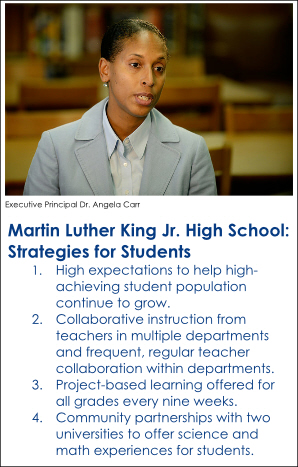How many drops of water can fit on the face side of a penny?
It’s a tough question. Even if you can assume that all drops are made with a common, measurable dropper, there’s a lot involved. Cohesion between water molecules allows for surface tension, creating a bubble that holds more water than you might expect. Several perspectives are required for complete understanding.
Students at SCORE Prize high school finalist Martin Luther King Jr. High School (MLK) answer this question – and many others – with collaborative instruction from teachers in multiple departments. In this case, math and science teachers help students use their knowledge of the properties of water to plot outcomes on a graph and study the resulting curves. It’s the kind of interdisciplinary work that helps students translate academic concepts to the real world, said Stacey Turner, Science Department chair at MLK.
“When students see things across several classes in different disciplines, it brings them insight,” said Ms. Turner. “Some teachers only teach their curriculum. For the bulk of us, I think we’re trying to get past that. We don’t teach to the test here.”
Teacher collaboration and interdisciplinary study underpin daily work at MLK, an academic magnet school in Nashville. These practices deliver real-world preparation for students and help draw significant academic gains from kids who are already strong performers.
MLK has about 800 students in the high school, as well as students, in grades seven and eight. Academically, students represent the top 10 to 15 percent of Metro Nashville Public Schools – admission requirements include maintenance of at least a “B” average and TCAP scores that are advanced or proficient. Once students are accepted, study is rigorous. High academic expectations must be met, including advanced math and science courses for all high school students.
MLK has achieved outstanding outcomes. The school has a graduation rate of 100 percent, and all students pursue post-secondary study immediately after high school. End-of-course assessment scores are well above state average. The schoolwide average ACT score is 25.9. Though it can be challenging to deliver high academic gains when students are already top performers, MLK posts strong three-year marks on TVAAS growth, especially in Algebra I and II.
“When you have a student who’s already at a high caliber, it’s hard to try to lift them to a higher level,” Ms. Turner said. “Starting at 799, it’s hard to get to 800.”
To meet students’ unique needs, rigor is incorporated in every classroom, and all material must involve higher-order thinking. MLK offers a robust selection of honors and Advanced Placement (AP) courses. Project-based learning experiences are planned every nine weeks for all grades.
Large-scale, multi-department initiatives are a well-loved part of each school year, like a “Diversity Day” event celebrating the more than 50 languages spoken by MLK students. Many school years feature an “All-School Read,” a book chosen by a different department each year for all students to read over the summer. In 2014 the entire school read Enrique’s Journey, a nonfiction account of a boy who travels from Honduras to the United States to reunite with his mother. When school resumed, English teachers facilitated discussion of the book, and teachers from other departments brought classes to hear speakers from different countries tell their stories. The book was chosen by the World Language Department.
MLK students also have interdisciplinary experiences with the help of community partners. Nashville’s PENCIL Foundation provides connections between schools and many local businesses and higher education institutions, including the Tennessee State University Biology Department and Baptist Hospital for MLK. Some MLK students also participate in the School for Science & Math at Vanderbilt University, a four-year high school program providing weekly laboratory experience and instruction from scientists and researchers on the Vanderbilt campus. The program is free and available to a select group of highly qualified MNPS students each year.
Teacher collaboration is an important part of providing MLK’s academic opportunities. Teachers work together constantly, utilizing the school’s 45-minute lunch periods as well as time outside class – including weekend talks and departmental planning over summer break. Classrooms are clustered by subject area throughout the building, facilitating communication throughout the day.
Departments make use of an MLK policy allowing teachers to use professional development days for selective work off-campus, said Executive Principal Dr. Angela Carr. The English department, for example, has used this time to collaborate in a variety of ways, including collective grading of writing assessments. Teachers can also work together to plan units and grade certain assignments quickly.
“If you stay on campus, you don’t always get much work done,” Dr. Carr said.
With students across grades 7-12, MLK makes use of its status as its own feeder school. For example, the entire math department meets regularly to work on vertical alignment of curriculum across all grades, adopting common practices for each course to help students progress smoothly between levels without missing concepts or wasting time.
This summer, educators have finalized plans to extend the middle school grades’ team structure to the ninth and tenth grades. This careful adjustment to the master schedule will give grade-level teachers a common planning period for working together, meeting with parents, and helping students, said Dr. Carr.
“We’re hoping for great things. We hope that it will have as positive an impact as it has had in the middle school,” Dr. Carr said. “We’re continuing to work and strive to improve each day.

